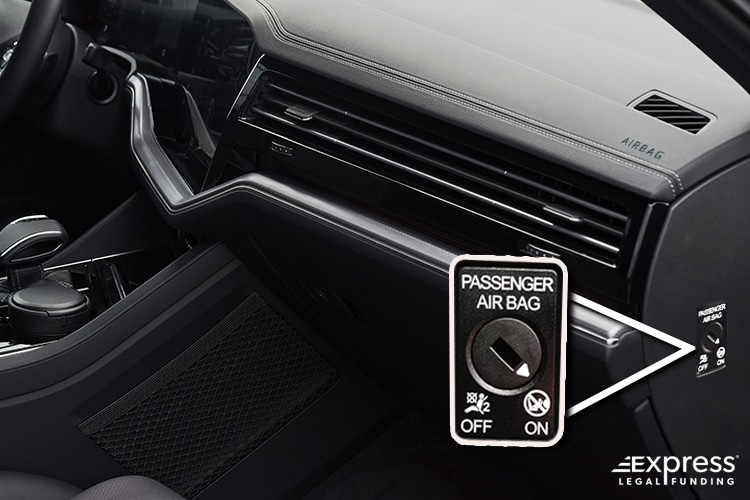Written by Aaron R. Winston
Last Updated: March 10, 2024 2:43pm CDT

etting into a car accident is no laughing matter, especially considering how large and fast motor vehicles have become.
The first automobile could only go 10 miles per hour at maximum speed, whereas modern civilian vehicles can reach 120-200 miles per hour, depending on the model.
Considering the most common top speed limits in the United States are 65-70 miles per hour, collisions nowadays are significantly more dangerous than in the late 19th century.
These increased speeds, combined with cars having larger and sturdier builds than ever, have made safety features necessary to protect motorists and their passengers.
As a result, several common safety tools have been implemented into automobile manufacturing as a matter of federal law. One of the car safety features is seatbelts, but the second most important is the airbag system.
Airbags are an essential tool that prevents motorists from experiencing severe injuries after a collision. They are not perfect, but they are proven to reduce the rate of fatal automotive crashes and the severity of injuries.
Despite the simple name, airbags (and their deployment systems) are complicated and use specialized sensors to determine when to deploy that safety measure.
Several devices and indicators also help the driver understand the current state of their car’s safety measures.
One such indicator is an airbag light that usually appears on the speedometer to indicate a car’s airbag status. Sometimes, the light does not work correctly and must be reset.
That, alongside other crucial airbag service light fixes and FAQs, will be the focus of this resource article.
Meaning, Purpose, and Instructions: How to Reset Car Airbag Light
When you see the airbag light on, the most significant questions are: Why is my airbag light on, and what does it mean?
Those crucial steps precede determining whether and how it needs to be reset.
What Does the Airbag Light Mean?
An airbag light, also known as an SRS “Supplemental Restraint System” light, is an illuminated dashboard icon of a person sitting with a large sphere in front of their face, which is meant to light up while driving to indicate there is a problem with your car’s airbag system.
A problem with the airbag system means the airbags may not deploy correctly in the event of a crash. Most often, it is placed near the check engine light.
Despite its simplistic stick-figure style, the airbag light turning on is a notification of a severe car safety issue.
What Does SRS Mean in a Car?
The acronym SRS in cars stands for “Supplemental Restraint System,” which is the extremely sensitive control module system that relies on sensor data to determine whether a collision warrants airbags to deploy.

Beyond airbags, the SRS system also encompasses the following vital parts:
- Seat belt pretensioners
- Airbag control module
- Other safety components.
The SRS control unit acts as the airbag system’s brain, processing crash data and status updates from various sensors.
When an inconsistency or fault is detected, the control unit will generate error codes, triggering the SRS light as an alert.
These sensors, while effective, are susceptible to damage that compromises the system’s ability to function properly.
If the airbag deployment system is compromised, it could threaten your health and safety, so resolving the issue is essential.
Why is My Airbag Light On?
Your car’s airbag light can turn on for many reasons, which typically indicate a fault (a break or defect in an electrical circuit or machinery) with your vehicle’s airbag system for several reasons, such as a depleted battery, water damage, or a bad clock spring.
5 Most Common Reasons for Why Airbag Lights Come On:
The most common potential causes for why the service airbag light on the dash will come on include the following reasons:
The Airbag Backup Battery is Depleted
The airbag’s backup battery (capacitor) might be depleted. This situation can happen if your car’s battery was completely drained recently, which can be due to issues like corroded battery terminals.
When this happens, it forces the airbag deployment system to rely on its standby power source.
Standby power sources are not designed to maintain the airbag system long-term, so the battery might have depleted before you could restore your car’s primary battery. A depleted backup battery might not cause an immediate issue.
However, it will still trigger the SRS maintenance alert and should be resolved by recharging or replacing it (This should be performed ASAP for safety).
Airbag Sensor Damage (From Minor Car Accident)
As mentioned, the airbag deployment system relies on sensors to identify the appropriate time to activate the safety measure.
So if these sensors are damaged (i.e., a minor accident without airbag deployment), the car will alert the driver since a faulty sensor can lead to the airbags triggering prematurely or failing to trigger at all.
That could cause injury or death depending on when or if they deploy.
Seatbelt Sensor Detects Unbuckled Driver or Passenger
Another sensor-related cause for the airbag light to come on is not due to damage. Instead, the airbag light dash icon can be triggered to illuminate by the seatbelt sensor, not detecting your seatbelt is fastened.

Small objects and debris, such as a paperclip or mechanical pencil lead, can get lodged in the seat buckle latch, obstructing the sensor, which impedes the supplemental restraint system from identifying that you already fastened your seatbelt.
Bad Airbag Clock Spring
Most airbag systems use the explosive deployment system pioneered by Yasuzaburou Kobori, which employs what is known as a clock spring.
What is an Airbag Clock Spring?
Airbags employ a clock spring to maintain a good electrical connection with a car’s other electrical systems.
A clock spring is made up of a flat multicore cable that is directly connected to the steering wheel and is supposed to coil out whenever it turns.
Unfortunately, this can cause the spring to wear out from simple driving rather than the airbags actually being used for their intended purpose.
Long-term use weakens or cuts off the electricity sent through the steering wheel that powers the airbag deployment system, which can prevent it from deploying upon impact.
A mechanic can help you install a new clock spring to resolve this potentially dangerous issue.
Flood and Water Damage to Car
Finally, one of the most common reasons you’ll see the airbag light activating is the module has water damage.

Your car can get water damage from your car being partially submerged in or driving through flood water (heavy rainstorms or hurricanes), such as a flooded river bank or a dead-end street.
Either way, the water might reach the car’s internal electronics and damage them.
That could affect your airbags, preventing them from functioning correctly and causing the airbag light to activate.
Once the issue is resolved, you’ll likely need to reset airbag lights to clear any warnings.
Unfortunately, knowing what the light symbolizes does not help you resolve the issue.
Even more unfortunate is that resolving the airbag light problem can occasionally be more complicated than we hope and not a standardized step-by-step process.
However, there are simple steps you can take to resolve an unresponsive SRS light.
How to Reset Airbag Light?
There are simple steps you can take to try and get the airbag light to shut off, which include the following:
The Classic Solution: Turn It Off and On Again
You have likely heard this phrase more times than you care to admit, but the tried and true “Have you tried turning it off and on again?” is a cliché solution for a reason.
Turn On and Turn Off the Car Ignition to Reset Airbag Light
Restarting your car’s ignition is akin to restarting a phone or computer, especially since there actually is a computer in your car.
Every modern vehicle has a computer to automate system settings and operate smart dashboards with built-in navigation or smartphone interaction (i.e., Apple CarPlay and Bluetooth car audio headphones).
If you notice your airbag light is on and are unsure why, there may be a technical glitch.
Therefore, you should pull over and park your vehicle when it is safe to before you attempt to restart driving with these simple steps.

The first step is turning off your car’s ignition and waiting for a few seconds to let all the equipment shut off.
After a few seconds, turn on the ignition switch again (depending on your car, this might be a button or a classic key turn ignition).
Try Rebooting Tesla to Turn the Airbag Light Off
For Tesla car models, this could involve performing a reboot (similar to turning off and on a Mac or Windows computer), which acts as fully turning off and on the electric car.
Important fact: When turning your car on, the airbag light is supposed to light up but will turn off after several seconds if there is no issue with the airbags.
So, if the airbag light in your car does not turn off automatically, it might be because there is an actual problem with your airbags that the light is trying to warn you about.
Check Passenger Airbag Switch
Multiple airbags are installed in motor vehicles, but the ones most commonly referenced by motorists are the forward airbags.
That is understandable since forward driver’s side airbags are most commonly portrayed in movies and TV shows, while passenger-side airbags are seldom represented.
However, as anyone with a more technical understanding of automobiles knows, multiple airbags are ready to deploy upon impact.
Forward Airbags are Required by Law
Additionally, these car experts know that forward airbags are required by law to be installed on both the driver and passenger sides of the vehicle, and the airbag light activates whenever these airbags or their deployment systems are compromised.
Most often, this is because something has compromised the system and not the airbags’ construction.
However, another potential cause for an illuminated airbag light applies to specific vehicles: a passenger airbag switch.
Where is the Passenger Airbag Switch?
The passenger airbag switch is located on the passenger door side of some cars (typically older vehicles). There is an on/off button that, when off, will prevent the associated front dash airbag from deploying.
NHTSA Advises Against Airbag Switches and Bans New Installations (With a Few Exceptions)
The National Highway Traffic Safety Administration (NHTSA) advises against (and does not allow new installations) using the airbag switch except for a few situations, generally where the airbag deployed on the passenger seat could harm someone.
How to Install Airbag Switch?
Only under a few particular circumstances does the NHTSA allow dealerships to install passenger airbag switches, meaning it makes sense to turn off the front passenger airbag (when it is more dangerous for an airbag to deploy), which includes the following:
- An adult passenger has a health condition putting them at significant risk of severe airbag deployment injury that outweighs the potential safety benefits.
- A special needs child under the age of 13 years old requires constant medical monitoring, which necessitates their riding in the vehicle’s front passenger seat.
- From a practical perspective, a rear-facing infant restraint must be placed in the front seat because the vehicle does not have a middle or back row or the rear seat is too small for the child restraint, as is the case with many coupes (i.e., Lexus LC or Ford Mustang Coupe)

When this passenger airbag switch is set to “off,” it triggers the airbag light to remind the driver that one of the airbags is not operational.
This switch is only found in older vehicles or cars that do not have rear seats.
If you are driving a newer model car with at least four seats, you will unlikely have this switch installed.
If your car was manufactured before 2010 or only has two seats, you might have one and should check to see if it was inadvertently switched off.
Buckle Your Seatbelt
You might have noticed that the airbag light’s design clearly shows the seatbelt.
While this might seem like a stylistic choice, there is a valid reason for the seatbelt appearing in the silhouette.
The airbag deployment system’s sensors check various details about the car and its passengers.
Part of the alert is designed to warn the driver if someone in a particular seat is at risk of injury (for instance, by not wearing a seatbelt).
The system detects an at-risk passenger by checking to see if the passenger-side seatbelt is fastened.
This triggers one of the sensor’s criteria and allows it to issue warnings if the passenger-side airbag is compromised.
Unfortunately, the sensors can make mistakes if the seatbelt is faulty.
Verifying whether a damaged seatbelt is the cause of your airbag light turning on is very easy, and the first step is turning your car on.
Once your vehicle is running, fasten each seatbelt individually and listen for the proper clicking sound.
After every seatbelt is fastened correctly, press the red button to release the belts and check if the light deactivates.
If the light persists despite every seatbelt being released, one of the latches may be malfunctioning.
As a result, the car believes the belt is fastened, and someone is sitting in the seat.

Determining whether the seatbelt is damaged or flawed will require you to seek out a mechanic since there might be another reason for the damage.
How do Passenger Seat Airbag Sensors Work?
Passenger seat airbag sensors are another technology that revolves around sensors installed in the seats that communicate with the airbag system.
These complex sensors are designed to detect weight and body size.
For instance, the passenger seat airbag sensor in the Toyota Sienna judges someone with an adult-sized body as being that of an adult.
Conversely, if the sensors detect a child’s weight distribution, they will notify the SRS airbag control module that a child is seated, regardless of their, in fact, are of adult age.
In addition to their complex design, these sensors are extremely sensitive to ensure passengers are adequately protected and mitigate the risk of airbag deployment injuries.
Most newer cars have passenger-side seat sensors to determine whether the airbags deploy by alerting the system that someone is seated there and might need the airbags in case of an accident.
Adjust Weight for Passenger Seat Airbag Sensor
Unfortunately, these sensors are prone to making mistakes if you use your seats for something other than people.
People often use car seats as impromptu storage for cargo like groceries or packages, but these items can occasionally trigger the airbag light.
If your cargo exceeds a certain weight threshold, the sensors will mistake it for a person and assume it is at risk of injury by the airbags.
You can use one of the following two methods to get the passenger seat airbag sensor to turn off when an item’s weight causes the airbag light to stay illuminated:
- You can move the items somewhere else (such as the floor or rear seats).
- You can fasten the passenger seatbelt.
The latter will cause the sensor to recognize that the “passenger” is secure and not in danger of injury.
You should refer to your car’s safety manual and instructions to identify if it is a safe method for your vehicle model.
The former will resolve this issue and cause the airbag light to turn off by the sensor no longer thinking someone is sitting in that seat.
Check for Software Update
The newer, more high-tech cars like Tesla’s Model 3 require routine software upgrades.
Typically, these are performed as “over-the-air updates,” which means the operating system’s update is downloaded via Tesla’s cellular data network.
Like Android and Apple mobile devices, these updates fix bugs and add new features.

So, it is entirely possible that your car’s airbag light is on due to the car’s computer system needing a software update to resolve the issue.
Call the Car Dealership
After trying the more standard steps to reset your airbag light to no avail, it can make sense to contact the car dealership where you purchased your car.
When calling, ask to be transferred to the maintenance department.
Once they are on the line, you can inform them about your car’s SRS light not shutting off.
They can advise whether any known defective parts or software problems require a faulty part being swapped or a software patch to fix a bug installed.
You will likely not have to pay for the repair since the standard manufacturer warranty should cover it if it is a common issue affecting many of the same make and model.
Also, you may need to go to an official dealership of your car’s manufacturer, regardless of where you purchased it (i.e., at an auction or a pre-owned car lot).
Troubleshooting with an OBD-II Scanner
Sometimes, the issue with an airbag light is so technical that nothing you do can deactivate the airbag light.
Fortunately, tools exist to determine whether the light is a false positive and can deactivate the light.
Specifically, a line of OBD-II scanners can connect to the diagnostic link connector in most motor vehicles.

Depending on the scanner’s quality, it can perform several functions, but you will need to do some market research to find one that can deactivate a faulty airbag warning light.
The connector is located under the steering wheel, and scanners have cables designed to plug into it and will run a diagnostic on the car for any underlying issues.
If the scan detects an underlying problem with your vehicle that could be causing the light to activate, it will show a code that correlates to specific mechanical faults.
What are the Types of OBD-II Trouble Codes?
There are four separate OBD-II trouble fault code categories, which include the following:
- P Codes: P OBD-II codes pertain to the vehicle’s powertrain systems, encompassing the engine, transmission, and associated accessories.
One of the more prevalent P codes car owners face is P0128, which indicates a coolant thermostat problem by illuminating the corresponding SRS warning light. Problems such as low or dirty engine coolant can trigger a P0128 code. - B Codes: B OBD-II codes pertain to the vehicle’s body, encompassing driver assistance, comfort, convenience, and safety features.
One common B code is B0028, which indicates that the front right side passenger airbag is having issues by illuminating the corresponding SRS warning light. A broken wire or a loose connector plug can cause B0028 codes. - C Codes: C OBD-II codes pertain to the vehicle’s chassis, encompassing brakes, steering, and suspension systems.
One of the more predominant C codes car owners face is C0040, which indicates a problem with the front right wheel speed sensor circuit problem by illuminating the corresponding anti-lock braking system (ABS) warning light.
Issues with the ABS module or a faulty wheel speed circuit can trigger a C0040 code. - U Codes: U OBD-II codes pertain to the vehicle’s communication networks, which link a car’s control modules so they can communicate.
These include the anti-lock braking system (ABS), transmission control module (TCM), and navigation control systems. One common U code is U0184, which indicates that the CAN bus lost communication with the radio. A dead battery can trigger a U1084 code.
Many auto parts chains, like AutoZone, will help you use their OBD-II scanner for free, and you can consult a directory of the trouble codes for an exact diagnosis (there are far too many to list in this article alone).
If the check airbag light still does not turn off after resolving the issue outlined in the code, more action is required.

You can purchase the parts needed to fix it, or if you don’t have enough car technician skills or time for DIY auto maintenance, you should visit a mechanic for an official diagnosis and possible repair (all of which can become increasingly expensive following a car accident).
Closing Statements About Airbag Lights
Among the myriads of safety features created to inform us of dangers are airbag lights made to warn motorists about issues with their cars.
While there are several possible causes for the SRS light to activate, not all are because of your actions or getting flooded by a surprise rainstorm.
For example, if your airbag light turns on after a motor vehicle accident, the collision damage is likely the trigger that caused one of the SRS issues outlined in this article.
That means your airbag system needs repair, which can be very expensive.
Fortunately, a crucial distinction exists for cases where the collision was someone else’s fault, not yours.
When you can rightly blame someone else for being responsible, you can take legal action and sue the at-fault party by filing a car accident lawsuit.
Lawsuits involving car accidents are civil claims that provide you the legal means to sue the other driver (often involving the liable driver’s car insurance company) to receive compensation for the injuries and damages caused to you, including money to repair or replace the cost of your crashed car.
You will most often receive money by settling for a cash settlement (instead of a jury trial award).
Lawyers negotiate settlements on behalf of their clients by mediating with the defendant (generally the at-fault party’s car insurance company.)
Please note you will almost always receive a larger settlement by hiring an attorney than by trying to settle yourself.
The point of these civil suits against the responsible motorist is to recover the money you have lost or are on the hook to pay due to the cost of medical treatment and car repairs.
That means you have suffered a loss of money from the accident and have to wait for your case to be settled or won before you can receive compensation as repayment.
A Leading Company in Pre-settlement Funding
We at Express Legal Funding understand this tough reality and know that you may need help with paying your regular bills and handling surprise costs resulting from the accident.
Most of this is where we can step in to help when you are dealing with unplanned expenses after a car accident.

Not to mention how being injured in a wreck caused by someone else’s recklessness can cause you to miss work and lower your income from being delayed or too injured to return to work.
Not to mention how you will likely have to deal with a lack of transportation while you have to wait for your car to be repaired (or replaced if it is totaled), assuming you have the funds to do so.
As a legal funding company, this is where we can step in to help when you financially need it most.
We can provide pre-settlement funding to people who have a pending lawsuit and are having to wait for it to be settled or won before they can get paid for their loss.
Getting pre-settlement funding means you receive an early advanced payment of a portion of your potential settlement money.
That’s because Express Legal Funding can advance cash funds to you in exchange for a portion of your potential case proceeds so you can have money now and not merely later when your case finally comes to a successful end.
Plus, since the advance is to be repaid from your legal claims proceeds, it is not a loan and, therefore, can’t make you go into debt at the end of your case if you lose (have no financial recovery).
Taking things a step further, that means if you obtain legal funding for your ongoing case but unfortunately lose, the funds are yours to keep (basically, no questions asked).
Please note that this is technically not the case for recourse lawsuit loans, which is the only type of consumer legal financing permitted in a select few states.
If you need cash to keep financially afloat and cannot wait to see your case to the end and for your settlement check to arrive, call us to learn more about and apply for legal funding.
It’s completely risk-free. We are here to help answer your call anytime, 24/7. (You can also apply for pre-settlement funding online day or night. We make it that easy.)
About the Author
Aaron Winston is the Strategy Director of Express Legal Funding. As "The Legal Funding Expert," Aaron has more than ten years of experience in the consumer finance industry. Most of which was as a consultant to a top financial advisory firm, managing 400+ million USD in client wealth. He is recognized as an expert author and researcher across multiple SEO industries.
Aaron Winston earned his title "The Legal Funding Expert" through authoritative articles and blog posts about legal funding. He specializes in expert content writing for pre-settlement funding and law firm blogs.
Each month, tens of thousands of web visitors read his articles and posts. Aaron's thoroughly researched guides are among the most-read lawsuit funding articles over the past year.
As Strategy Director of Express Legal Funding, Aaron has devoted thousands of hours to advocating for the consumer. His "it factor" is that he is a tireless and inventive thought leader who has made great strides by conveying his legal knowledge and diverse expertise to the public. More clients and lawyers understand the facts about pre-settlement funding because of Aaron's legal and financial service SEO mastery.
Aaron Winston is the author of A Word For The Wise. A Warning For The Stupid. Canons of Conduct, which is a book in poetry format. It consists of 35 unique canons. The book was published in 2023.
He keeps an academic approach to business that improves the consumer's well-being. In early 2022, Aaron gained the Search Engine Optimization and the Google Ads LinkedIn skills assessment badges. He placed in the top 5% of those who took the SEO skills test assessment.
Aaron's company slogans and lawsuit funding company name are registered trademarks of the United States Patent and Trademark Office. He has gained positive notoriety via interviews and case studies, which are a byproduct of his successes. Aaron R. Winston was featured in a smith.ai interview (2021) and a company growth case study (2022).
In 2023, Aaron and Express Legal Funding received accolades in a leading SEO author case study performed by the leading professionals at WordLift. The in-depth data presented in the pre-settlement funding SEO case study demonstrate why Aaron Winston maintains a high-author E-E-A-T. His original writing and helpful content continue to achieve unprecedented success and stand in their own class.
Aaron was born in Lubbock, TX, where he spent the first eight years of his life. Aaron attended Akiba Academy of Dallas, TX.






